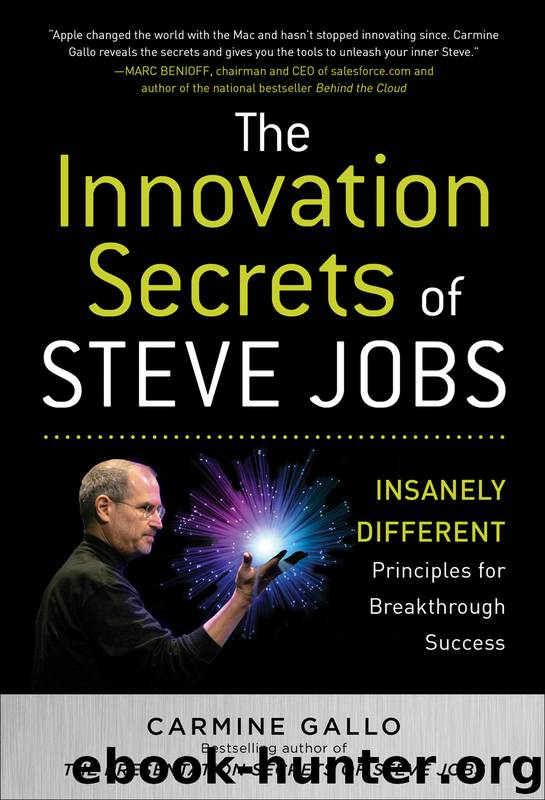The Innovation Secrets of Steve Jobs by Carmine Gallo

Author:Carmine Gallo
Language: eng
Format: epub
Publisher: McGraw-Hill
Published: 2011-05-09T16:00:00+00:00
THE RECIPE FOR DIGITAL MUSIC
Apple did not introduce the iPod in 2001 to start a revolution; it introduced the iPod to solve its customers’ pain. The digital music players of the time that were based on small memory chips could store only a few dozen songs, not much better than a portable CD player. A few products based on a new, 2.5-inch Fujitsu hard drive could hold potentially thousands of songs but had a fundamental flaw: excruciatingly slow speeds from the computer to the player. Apple had the solution: FireWire.
On October 23, 2001, Steve Jobs introduced the first iPod: “1,000 songs in your pocket.” He described it as a quantum leap in listening to music, because listeners could carry their entire music libraries in their pockets. In his presentation, Jobs spent several minutes on FireWire, demonstrating exactly how the iPod would solve the problem of painfully slow transfers. Apple developed FireWire in the 1990s as a method of delivering information very quickly between digital devices. By incorporating the technology into its new music player, Apple solved a problem that music fans had complained about. Here’s how Jobs revealed the solution:
Apple invented FireWire, and we ship FireWire on every computer we make. It’s built into iPod. It’s the first and only music player with FireWire. Why? Because it’s fast. You can download an entire CD onto an iPod in five to ten seconds. Let’s take a look at how it compares to USB. Five to ten seconds to load an entire CD with FireWire. On a USB, you’re talking five minutes. Let’s talk about one thousand songs. On iPod with FireWire it is under ten minutes, on a USB player it is five hours. Can you imagine? You get to watch it for five hours as it loads the songs. Under ten minutes with iPod. It’s thirty times faster than any other MP3 player.12
Of course, there were other notable aspects of the iPod. It had a scroll wheel for easy navigation, ten hours of battery life, a small form factor (the size of a deck of cards), and Apple’s classic ease-of-use design elements. In short, the iPod was a much better digital music player. But it was not a radical innovation. The “technology epiphany” occurred two years later with the launch of the iTunes Music Store.
On April 28, 2003, Steve Jobs redefined what it meant to acquire and enjoy music. In Verganti’s words, Jobs made a proposal to his customers—one that no focus group would have offered: in return for paying for music, only ninety-nine cents a song, customers would enjoy a more satisfying music experience. If he had simply listened to his customers, none would have told Jobs that they wanted to pay for music. Jobs had to change the way his customers thought about their experience. He did so by starting with a history lesson. “We all know that in 1999, there was this phenomenon called Napster. It was shut down in 2001, but it demonstrated some things for us.
Download
This site does not store any files on its server. We only index and link to content provided by other sites. Please contact the content providers to delete copyright contents if any and email us, we'll remove relevant links or contents immediately.
Hit Refresh by Satya Nadella(9035)
The Compound Effect by Darren Hardy(8805)
Change Your Questions, Change Your Life by Marilee Adams(7630)
Nudge - Improving Decisions about Health, Wealth, and Happiness by Thaler Sunstein(7609)
The Black Swan by Nassim Nicholas Taleb(7009)
Deep Work by Cal Newport(6873)
Daring Greatly by Brene Brown(6442)
Rich Dad Poor Dad by Robert T. Kiyosaki(6397)
Principles: Life and Work by Ray Dalio(6201)
Man-made Catastrophes and Risk Information Concealment by Dmitry Chernov & Didier Sornette(5920)
Playing to Win_ How Strategy Really Works by A.G. Lafley & Roger L. Martin(5909)
Digital Minimalism by Cal Newport;(5661)
Big Magic: Creative Living Beyond Fear by Elizabeth Gilbert(5608)
The Myth of the Strong Leader by Archie Brown(5420)
The Slight Edge by Jeff Olson(5345)
Discipline Equals Freedom by Jocko Willink(5275)
The Motivation Myth by Jeff Haden(5154)
Stone's Rules by Roger Stone(5025)
The Laws of Human Nature by Robert Greene(4995)
